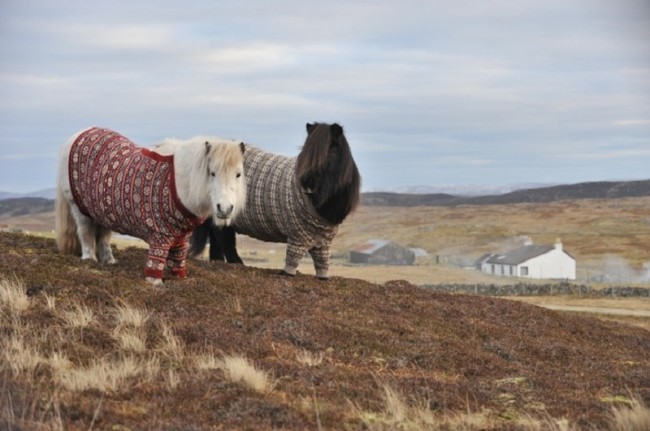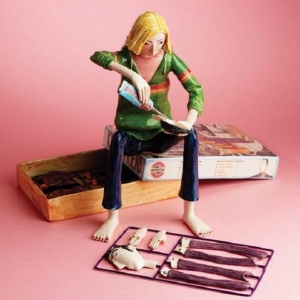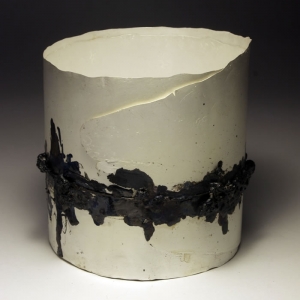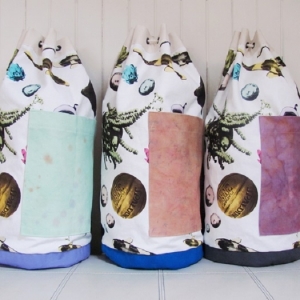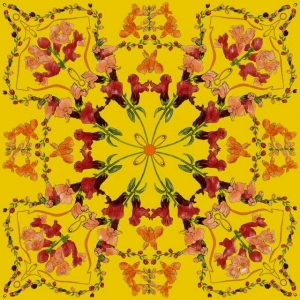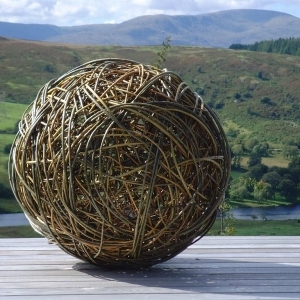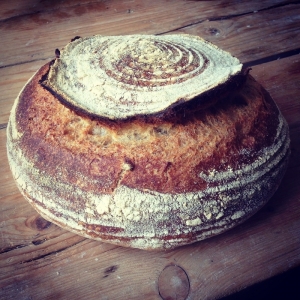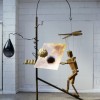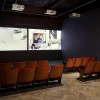Talking at the beginning of the two day conference, Stofer set the tone: outlining questions and ideas concerning education, definition and purpose which would recur through the following presentations and discussions. His talk was a particular highlight of the weekend, being both inspirational and easy to relate to from a personal point of view for many who work in craft. It was closely followed by several other talks during the first day, including a presentation by Fi Scott and Vana Coleman, the duo behind Make Works, and a conversation about the creative ecology of the city between the curator Amanda Game and Philip Long, the director of the V&A at Dundee.
The Saturday afternoon discussion session focused on the question of a potential craft renaissance in Scotland. Delegates were asked to consider what this rebirth would include, and what they would hope to see come out of it. All of the feedback which came out of these sessions reflected the commonly recurring themes of definition and practice, and how craft is taught in both universities and secondary schools.
These are not topics which are necessarily surprising or new, but are rather an ever-progressing discussion that helps develop a sharper understanding of craft, and its role in contemporary society. For example, how and why craft should be taught in both schools and universities is a topic that arises as a matter of routine, both as part of multidisciplinary conferences and as a focused subject within itself, such as the 1998 British Crafts Council conference, Learning Through Making. On this occasion, Professor Phil Roberts gave a presentation making a case for the value of practical making not only for craft subjects within themselves but also as a valuable educative tool, which was a sentiment echoed by Stofer and the Glasgow-based initiative MAKLab – who ran one of the Sunday workshops – in the present day.
MAKLab is a digital fabrication studio, providing open access to production machinery and resources for both professionals and the public. Their workshop began with a discussion of how the networks and connections of each delegate interlink across profession and location. The aim was to determine where gaps exist, and how these might be bridged; the interchange of ideas is as much a part of the MAKLab’s function as the availability of resources. While this exercise itself was interesting enough, the natural, conversational way in which ideas travel in a creative environment was made more tangible during the following showcase of some of the studio’s equipment, as delegates were given the opportunity to have quiet conversations with some of the MAKLab’s members, and ask further questions about their work and the machines.
MAKLab is actively trying to bring this exchange into secondary schools and to teach making skills at an earlier age, inviting classrooms and youth groups into the studio to undertake projects which have a direct impact on their social and learning environments. It is a proactive and encouraging attempt to address some of the shortcomings in arts education for children and teenagers. Their initiative supports an argument for the problem-solving skills, therapeutic nature, and the ownership that comes from making.
However, as reassuring as it is to see initiatives like this, actively trying to engage communities and children as well as contemporary makers, it still feels as if much more needs to be done in response to craft education. There is a significant decline in expensive specialist subjects such as ceramics and glass at degree level, particularly in Scotland where there are no longer any undergraduate ceramics courses. Instead, these subjects are often incorporated into multidisciplinary degrees, where it could be questioned whether the skills that embody the term craftsmanship are fully being learnt. Similarly, at the secondary school level, a fellow delegate at the conference raised the point that there are many kilns and ceramics facilities which are not being put to use because there is neither the funding or the teaching skill to be able to do so. While much effort is being made to address how making skills are taught, the overall impression is that we are still a long way from reconciling the framework and budgetary restriction of formal education with creative subject. Early education and the chance to creatively experiment at a higher level are often informative experiences for many makers, which ultimately impact on how they later develop as artists, designers and manufacturers. As such it might have been constructive to hear more on this issue over the course of the weekend.
As part of the central theme of a contemporary craft renaissance, discussions naturally led back to how we interpret ‘creative practice’, both collectively and personally, and how to support makers and ensure the availability of resources. In particular, they were questions asked as part of the conversation between Game and Long, as both speakers and delegates sought to understand how the new V&A would help to support craft and design in Dundee and Scotland. Especially telling in this exchange was Game’s reluctance to give a definition of craft, despite thirty years experience in writing and exhibiting contemporary craft and design.
An unwillingness to confine craft within a set definition recurred often throughout the two days. A series of presentations on the Saturday provided a number of perspectives on the different ways in which makers balance their art and the commercial side of their practice. However, what was most striking in this session was the variety of ways in which ‘making’ can be applied. This served to reiterate Stofer’s list; as presentations were given by independent designer/maker Laura Spring, who works primarily in printed textiles and has designed a series of bespoke luggage and clothing, all the way to Bakery 47, an artisan home-bakery in Glasgow.
Bakery 47 may not seem like the traditional idea of what craft is or should be, and they demonstrate an interesting point that craft is as much about a mentality or an ethos as it is a specific set of skills, and as such were definitely some of the most inspired speakers selected for the conference. Bakery 47’s produce demonstrate a great deal of aesthetic sensibility as well as excellent baking skills, however the way in which the business is promoted and developed is extremely important to its founders, owners and sole staff: Tom and Anna Luntley. Which raises another stand out point of the weekend; a question of why do businesses have to constantly grow to be considered successful?
This year’s review by the Department for Culture, Media and Sport (DCMS) was an inevitable part of this discussion. In April this year, the DCMS published their proposed changes to how they classify and measure the creative industries. It was a move met with great concern as the changes seemed to suggest that craft industries would no longer be included under the organisation’s mandate, which would have vast impacts on funding and how agencies such as the Crafts Council, Arts Council, Creative Scotland and Craft Scotland could support makers and artists. Through the consultation process, which concluded in June, the DCMS clarified their proposal and put forward assurances that craft would continue to be included in their classifications. However, the reason these concerns arose is due to the difficulty that is often experienced when attempting to measure craft industries, as they are generally small businesses that bring in comparatively low revenue in a world of globalised, international corporations.
This environment creates pressure for makers to create businesses that perpetually grow from an economic perspective, because if they do not push the commercial side of what they do, they run the risk of being overlooked. However, Bakery 47 are adamant in their approach to what they do; they have no intention of buying a shop, employing extra staff, or publishing a cookery book. They deliver by foot and by bicycle to their local area in south Glasgow, and a few carefully selected cafes in the city, and they find more satisfaction in the relationship they have with their regular customers within their community than they would by building a larger business. It is an approach that considers how the business can develop creatively rather than economically, and it is these two different sides that sum up the balance and concerns felt by many makers and it important that this be recognised by those forming the policies and measures by which these industries are judged. The fact that Craft Scotland brought them into the conference is in itself very encouraging, and gives a sense of how the organisation and Creative Scotland are listening to the views of makers.
Inevitably, there is so much more which could be said about this year’s Craft Scotland Conference, but these questions of education, definition and practice remain the most resonant and through re-examining them we can gain understanding of how we move forward each year. It is also important as a means of seeing how agencies like Craft Scotland facilitate projects, create connections and highlight the work of both individuals and groups, so that we can have confidence in their work and ability to support the sector.
The only real criticism I would make of the conference is the variety of people it caters for; it advertises itself as being open to makers, curators, enthusiasts, and so on, which it does live up to more or less, and the Saturday in particular had a wide appeal to all professions. However, the Sunday, which was made up of morning and afternoon workshops, seemed far more directed at makers. While I did enjoy my morning at the Vanilla Ink jewellery workshop, and my afternoon with MAKLab, it would have been nice to see a bit more variety of choice in these activities, and a slightly wider recognition of the fact that as much as makers need a bit of help with pricing their work and so on, curators and enthusiasts need some advice every now and again on how they can help promote and support craft, and the work of the artists and makers which they feel so passionately about.
